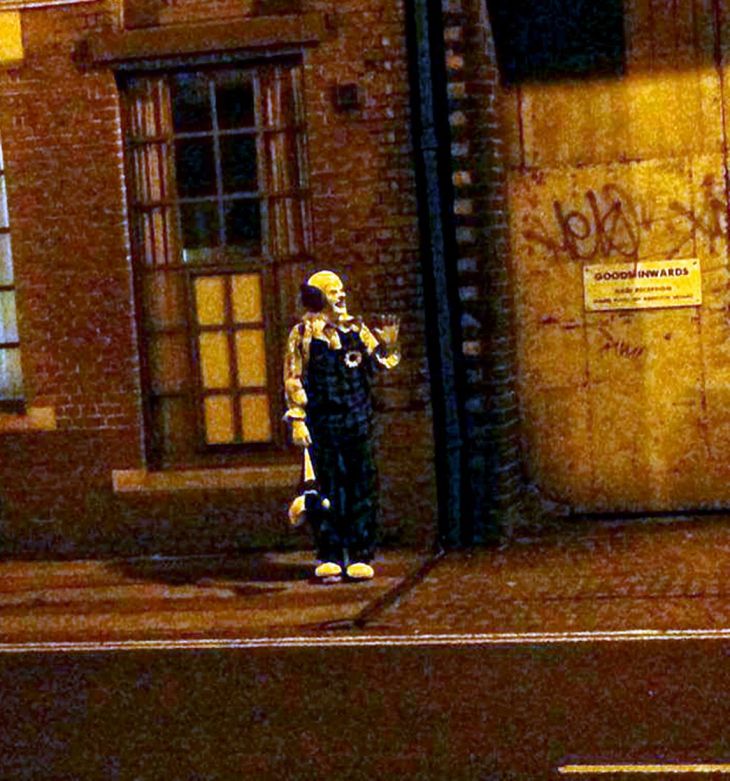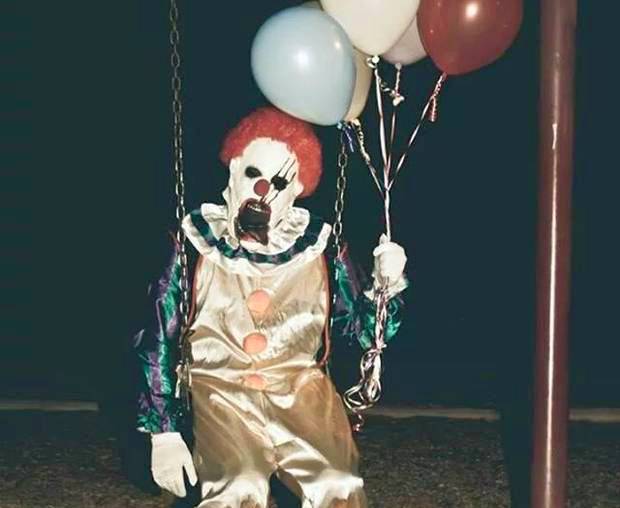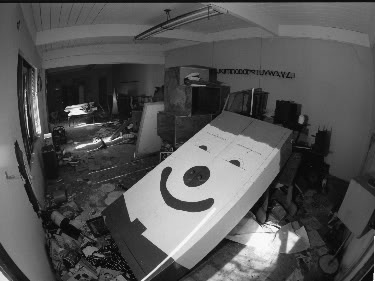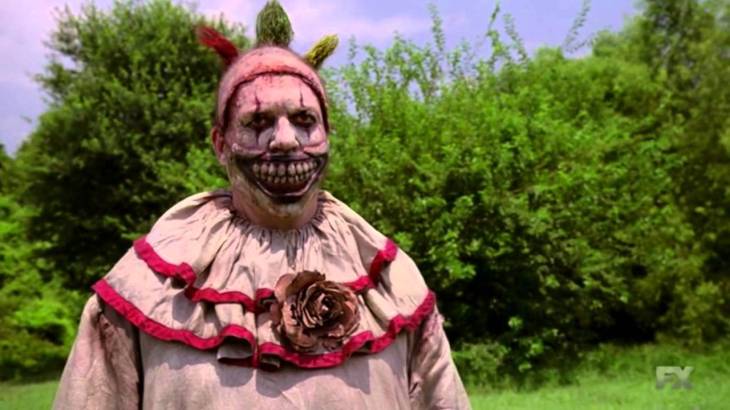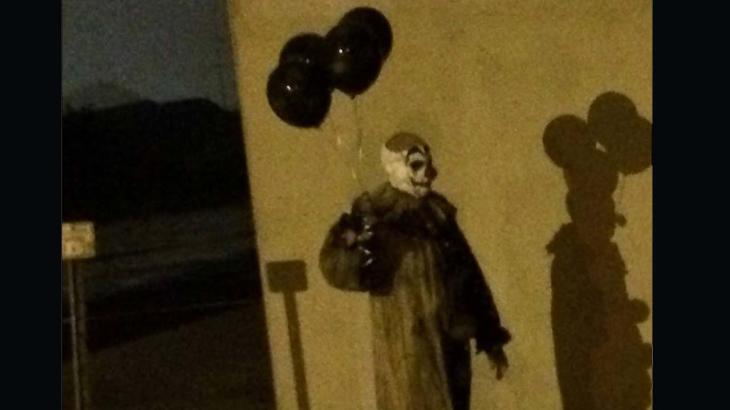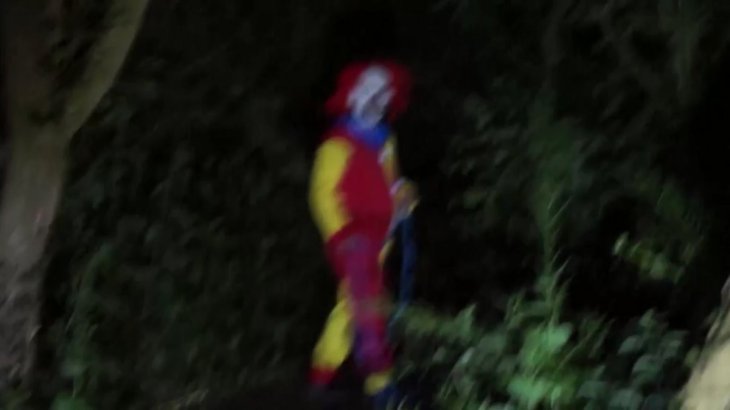“You realize a clown is just a transvestite that doesn’t stop?” – Patton Oswalt
“I don’t remember killing anyone. I could have done it without knowing it. I’m not sure if I did it.” – John Wayne Gacy
“If you’re the fucking…oh, God, the cops…and if you’re the fucking cops, go fuck yourselves. Because you’re full of shit.” – David Friedman, AKA Silly Billy
“Want a balloon?” – Pennywise the Dancing Clown
Clowns have a bad rep. Maybe it’s because the famous clown Joseph Grimaldi was beaten and forced into clowning by his brutish father. Perhaps it’s because of that Jerry Lewis film no one has seen. Or the Peter Straub story “Something About a Death, Something About a Fire”, in which Bobo the clown entertains the souls of circus-goers who don’t recall burning to death in a big top conflagration.
Nah.
It’s because clowns are creepy as hell. We all know this. The only exceptions are tramp clowns and mimes – they’re hellishly annoying rather than sinister. And now that literally no one on the planet enjoys maudlin hobo antics or invisible boxes anymore, it’s little wonder the clown industry bemoaned the imminent death of clowning two years ago.
But then the evil clowns started to appear.
Actually, they first showed up in 2013, in the English village of Northampton. That autumn, a clown clearly modeled after Pennywise was photographed all over the place, usually with a fistful of helium balloons. A “Spot Northampton’s Clown” group popped up on Facebook, and locals began clown-hunting with cameras.
The Northampton Clown finally granted an interview to the local Chronicle and Echo, in which he explained that he was just trying to amuse people, and was later outed as university student Alex Powell. It was Powell’s buddy, Luke Ubanski, who started the Facebook group.
The next evil clown surfaced in Wasco, California in 2014. This guy (or group of guys) was much spookier, because he/they wore masks. But he seemed pretty harmless. He posted pics on Twitter and Instagram, encouraging people to find him. Despite rumours of break-ins in the neighbourhoods where he was photographed, the Wasco clown was never officially linked to any crime. He has not been identified, though an anonymous man claims the Clown was an art project created by himself and his wife.
Wasco copycats soon surfaced in Bakersfield. There were rumours that one clown was armed with an axe at Golden Valley High School, though the principal assured local media the incident was a hoax. Another, unarmed, clown was arrested for chasing teenagers. “We will make arrests on this,” Bakersfield Police Sgt. Joseph Grubbs vowed. “We want this to stop.”
These evil clowns are indisputably real, flesh-and-blood people with too much time on their hands. They were photographed, filmed, and even arrested. But what are we to make of the clowns that are never found, the clowns that seem to exist somewhere between everyday reality and the fathomless depths of the subconscious?
This has happened. In the spring of 1981, school districts in and around Boston were suddenly besieged by reports of clowns trying to lure kids into black vans. Children in the Massachusetts towns of Brookline, Jamaica Park and Cambridge reported being menaced by such clowns. Daniel O’Connell, a counselor for the Boston Public School District, issued a district-wide clown warning to teachers and parents. Cops began pulling over any male driver in full-face makeup.
The initial wave of sightings that occurred around the Lawrence Elementary School in Brookline involved highly detailed description of the clown car. It was an older-model brown van with one busted headlight, no hubcabs, and a metal ladder affixed to the side.
Weird thing is, no one over the age of about 7 ever saw that van or the clown. Eventually, the police decided that these were probably bogus clowns created by overly-imaginative kids. Which is even spookier than real clowns, when you think about it.
But what are we to make of the sightings that occurred later on, throughout the summer of ’81? The clown panic spread from Massachusetts to Rhode Island, then abruptly leapt over to the Midwest. In Kansas City, numerous children saw a black-faced clown wielding a large knife or a sword. He often drove a yellow van, which was seen by at least one adult. Again, the descriptions were highly detailed; the clown wore a black shirt imprinted with a “devil face” and trousers with candy cane designs on the sides. He was spotted near half a dozen schools in Missouri before disappearing forever.
In Pittsburgh, a clown duo was said to be following children. Then a man in a pink rabbit costume began appearing, notably in Allegheny Cemetery.
In his Fortean tome Mysterious America (1983), cryptozoologist and self-proclaimed suicide expert Loren Coleman analyzed the clown panic of ’81 and coined the term “phantom clowns” to describe it. While he doesn’t dismiss the notion that some of the clowns were imaginary, he finds it baffling that clown panic managed to jump from state to state with little help from major media outlets or law enforcement. Each community that experienced clown infestations was unaware of the clowns appearing in other states, Coleman contends.
This seems to leave out a lot of possibilities. Isn’t it feasible that contagion was spread across state lines by teachers, parents, and students? Even in a pre-Internet age, word travels quickly when high strangeness is happening.
Others have pointed to events in the late ’70s and early ’80s that might have helped sparked clown panic, including the Atlanta child murders and the excavation of Gacy’s crawlspace. There was also the high-profile disappearance of little Etan Patz.
It’s easy to look back on the clown panic and blame it on everything from B movies to Shriners.
The thing is, though, the phantom clowns never really went away. And they’re not always phantoms.
Many of the bogus Satanic ritual abuse cases of the ’80s involved sadistic child molesters dressed as clowns. The infamous McMartin Preschool case in Manhattan Beach, California, included a few references to clowns, possibly because the daycare had a free-standing cabinet painted to look like a clownface.
Throughout the late ’80s, parents in the village of Oude Pekele, in the Netherlands, became convinced that youngsters were being scooped up and subjected to monstrous tortures by people in vans. Many of these phantoms wore clown costumes.
In spite of multiple investigations and intensive questioning by psychiatrists, not one suspected child molester was ever identified in Oude Pekele. The children of the town weren’t even out of their parents’ sight long enough for such things to occur. No adult ever saw a clown trolling the streets in a van.
Clowns were also mentioned in the Fells Acre daycare abuse case that began in 1984, resulting in the convictions of an entire family, including elderly Violet Amirault. There is evidence that a pediatric nurse involved in the case pressured the kids to talk about abuse. From the Fells Acre Wikipedia entry: “The children repeatedly told interviewers, including [nurse Susan] Kelley, that nothing happened to them, that there were no secret rooms, and there was no clown. However, the questioning continued and eventually the children claimed all these things happened…At one point, an interviewer told a child that the child’s friend had already testified that the clown had them take their clothes off. The girl being interviewed denied this happened, at which point the interviewer said that she believed what the child’s friend told her.”
Those who continue to believe in the reality of Satanic ritual abuse in spite of the dearth of evidence still insist that the perps must have worn costumes to confuse and discredit their child victims. Note, however, that no costumes were discovered in any of these cases.
Fortean researcher Paul Meehan claims that around 1990, his daughter’s public school in Queens, New York, issued a notice about a clown hassling students. This would have been the first full-blown clown panic since the mid-’80s, when a few communities experienced brief outbreaks. In ’86, a newsletter sent to teachers and parents darkly warned that kids who encountered clowns in vans could end up on milk cartons. Never mind that there still hasn’t been a single case of an adult in clown costume abducting a child. Remember, Gacy’s victims were older teens that he lured with promises of construction work, not balloons.
In the summer of 1991, schools in South Orange, New Jersey, Chicago, and other cities were gripped by rumours that a clown called Homey – after Damon Wayans’ character on In Living Color – was driving around in a van, trying to kidnap children.
One boy claimed he had been shot at by a clown toting an Uzi and brandishing a machete. He was able to escape by hurling his backpack at the fiend. This kid ultimately confessed to making up the entire story (duh).
Hundreds of schoolkids were affected by the Homey rumours, yet there wasn’t a single documented sighting other than the fake Uzi Clown.
In the summer of 1994, the D.C. area was plagued by phantom clown sightings at the same time as Pasadena, California.
In 1995, the most sinister clowns yet were said to be terrorizing Honduras. According to rumours, clowns were riding around in ambulances and cars, scooping up children who were never seen again. No actual clown sightings or abduction attempts were documented, though.
In 2000, Fitchburg, Wisconsin was beset by another black-faced clown. From the Wisconsin State Journal of Madison (June 20, 2000): “A man dressed in a complete clown costume and holding three helium balloons tried to lure children into woods near the King James Court apartments, at about 12:30 PM Monday, Fitchburg Police said.”
In 2008, a clown with teardrops painted on his cheeks was seen by children in Chicago. He reportedly attempted to lure them into an old van with broken windows. As in the ’81 cases, no adult glimpsed the clown and no children were actually harmed.
Then, of course, there were actual clowns committing actual crimes. In Ontario, former clown Linda Beaudoin has been leading a largely one-woman campaign for legislation that would require children’s entertainers to be licensed. She attended the child porn trial of Randy Miller, AKA Honker the Clown, in 2011.
In October 2014, creepy clown sightings were reported all across the U.S., likely as a result of the Wasco Clown and possibly the character “Twisty the Clown” on the fourth season of the anthology series American Horror Story.
Real clowns were growing extremely annoyed with evil clowns by this point. The president of Clowns of America International, Glenn Kohlberger, responded to Twisty with a firm position statement: “We do not support in any way, shape or form any medium that sensationalizes or adds to coulrophobia or ‘clown fear.'”
At the same time, more than a dozen teenagers wearing clown costumes were arrested for harassing pedestrians in southern France. This was just one of many “clown malefique” incidents occurring throughout France, where dressing up as clowns and terrorizing strangers with axes, knives and other weapons practically became a sport.
It began in the northern part of the country, with school sightings eerily similar to the ’81 clown panic in the States. Soon, however, the clowns were getting aggressive. In Besançon, a man was injured trying to defend himself from a chainsaw-wielding clown, while in Montpellier a clown with an iron bar chased down and beat a man. One village got so fed up with asshole clowns that it banned clown costumes for a month. In other areas, anti-clown vigilante groups – “chasseurs de clown” – were formed. Things got so heated that in late October, the Police Nationale warned that “anyone, regardless of whether they are an aggressive clown or a clown-hunter, found with a weapon in public thoroughfares will be arrested.”
Think about this for a minute. The French have a demonstrably high tolerance for clowning. France has more mimes per capita than any other nation, with zero mime-related homicides (well, except for that one time a mime killed a child-fan for uttering his stage name in public).
So if even the French are fed up, clowns have become a problem.
The frustration is not limited to France. Alex Powell claims he received hundreds of death threats during his run as the Northampton Clown, and (as we’ll see) South Carolinians are getting close to the snapping point.
In October 2015, Hillview School for Girls in Tonbridge, Kent, was at the centre of a clown infestation. Clowns in vans were also sighted on St. John’s Road in Tunbridge Wells that month, and one fuzzy photo was snapped. Police and teachers issued warnings to schoolchildren to go straight home from school, even though these particular clowns weren’t doing anything. They simply wandered around in clown masks. One was identified as an 18-year-old girl.
Now, in 2016, we are in the grips of another clown wave. Wisconsin was hit again in August, by a “dirty clown” roaming Green Bay with black balloons. This turned out to be the work of one Adam Krause, who wanted to draw attention to his short film about a creepy clown.
Also in August, parents living in the Fleetwood Manor Apartments in Greenville, South Carolina, began complaining to police that people in clown costumes have attempted to entice children into a nearby wooded area. Kids aren’t the only ones seeing them this time.
The Greenville sightings began on August 19, when Donna Arnold’s son told her he had encountered a gang of clowns in the woods, “whispering and making strange noises.” She later saw them herself, beaming green laser-lights.
The kids say some of the clowns carry knives and chains, and try to tempt them with fistfuls of cash or candy.
As panic climbs, the apartment managers are encouraging residents to monitor their children at all times and keep them out of the woods. The problem is, the clowns aren’t restricting themselves to wooded areas. They have been seen loitering around basketball courts and dumpsters, too. And they have been spotted near at least three other Greenville apartment complexes.
Greenville Police Chief Ken Miller has declared that clowns will be arrested, since South Carolina law forbids concealing your identity in public.
There is speculation that the clowns are part of a viral marketing campaign for the upcoming Rob Zombie killer-clown flick 31, but that’s doubtful. Impersonating child molesters in the woods isn’t going to sell movie tickets.
Numerous media outlets are taking a skeptical approach to the Greenville Clowns. The Atlantic (which has been oddly at the forefront of recent clown panics) suggests there simply aren’t any. It’s true that in the two weeks since the first clown was spotted, only one guy has managed to snap a single blurry photo (below). That’s sketchy. However, France’s clowns malefique have finally proven that phantom clowns aren’t always phantoms. Sometimes, they’re just jerks with makeup.
The South Carolina clown infestation is troubling. The residents of Fleetwood Manor are working-class people living in an economically depressed area at a time of deep social unease. Undoubtedly, some of them are armed. There are already reports of people firing into the woods to spook the clowns.
How long will it take for someone to fire on a suspected clown? Will the folks of Greenville become the next “chasseurs de clown“?
Further Reading:
“Scary Clowns Are Terrorizing France“, The Atlantic
“Cotton Candy Autopsy: Deconstructing Psycho-Killer Clowns” chapter in The Pyrotechnic Insanitarium: American Culture on the Brink by Mark Dery
“The Phantom Clown Panic” chapter in The Martians Have Landed!: A History of Media-Driven Panics and Hoaxes by Robert Bartholemew and Benjamin Radford
